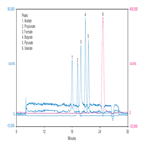Find methods for your needs
Refine by Feature
Displaying 1-4 of 4 results for Tag: sea water
AU168: Determination of Transition Metals in Complex Matrices
Instrument Type: ICChelation ion chromatography facilitates the determination of low concentrations (μg/L and lower) of transition metals in samples including seawater, brines, estuarine waters, and a variety of biological samples. Here, the authors simplify the system configuration described in Technical Note 25, using an ICS-3000 system. The separation has also been updated to include the IonPac CS5A/CG5A column set, which demonstrates improved selectivity and peak efficiency for separation of transition metals compared to the CS5.
AN269: Identification and Quantification at ppb Levels of Common Cations and Amines by IC-MS
Instrument Type: ICMSThe work shown here demonstrates the use of IC-MS for the determination of six commonly found cations and selected amines on an IonPac CS12A-5µm column. Confirmatory information was obtained using full-scan MS spectra showing positively charged cation species and characteristic adduct patterns. Quantification was achieved using selected ion monitoring (SIM) acquisitions for each target analyte.
AN69: Determination of Aluminum in Complex Matrices Using Chelation Ion Chromatography
Instrument Type: ICDetermination of trace metals in complex matrices has been a difficult analytical challenge. This application note describes the extension of Chelation ion chromatography for the analytical determination of aluminum in complex matrices. This technique allows aluminum to be preconcentrated from matrices high in salts, acids, or bases. Following selective concentration, aluminum is eluted to a conventional cation exchange column for separation from other transition metals. Selective detection is accomplished using post-column derivatization with Tiron and subsequent UV detection at 310 nm.
AN1000: Direct Determination of Small Organic Acids in Sea Water by IC-MS
Instrument Type: ICMSThis application demonstrates a 2D-IC-MS system that allows low levels of small organic acids (C1–5) to be analyzed in a high-ionic-strength matrix. The first dimension of the system separates the low-level analytes from the matrix while the second dimension resolves each of the target analytes. The mass spectrometer confirms identity and achieves low detection limits for a sensitive and selective assay. No special sample preparation was required and the results show good precision and reproducibility.




